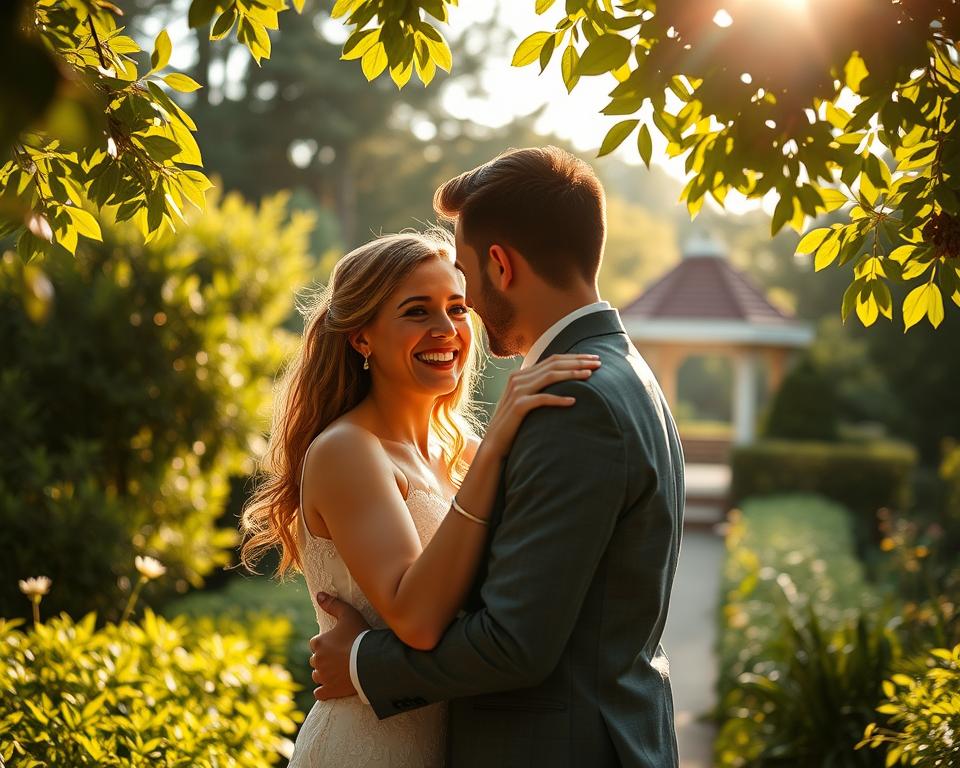广告
Engagement tips can calm planning and help your photos feel natural, but what small change makes a proposal truly yours?
Think about this: a short script, the right light, and a clear plan for time can stop nerves and let the moment breathe. Many guides stress logistics—how, where, and when—and show how a few rehearsal lines reduce the freeze-up some people feel.
A photographer often recommends an engagement session to ease wedding-day camera nerves and to build comfort between you and your partner. You can discreetly size a ring by borrowing one and using a measuring guide, and common metals like gold or platinum are usually resizable.
This guide is informational and draws on practices used by working photographers. Use these ideas as starting points: test what fits your culture, timeline, and budget, then adapt each suggestion to your life.
Introduction: Engagement tips for planning the moment, the photos, and the memories
Practicing a short proposal script helps you move through the moment with calm and clarity. Write a few beats and rehearse them aloud. Keep lines short so you can stay present with your partner.
广告
Why your plan benefits from a “movie script” mindset
Think like a director. Outline simple beats—arrive, connect, share a memory, speak your heart. That structure keeps the scene flowing like a short movie and avoids stiff performance.
How pre-wedding sessions reduce wedding-day camera nerves
An engagement shoot gives real practice with a photographer’s cues. You learn to move, to listen, and to relax when the camera is near. Use this as life practice, not a show.
- Make sure you and your photographer agree on tone—editorial, lifestyle, or a blend.
- Block the best time for light and allow small schedule adjustments for weather.
- Keep a brief guide on your phone and update it as you gain confidence.
The modern engagement landscape in the United States
Customs born centuries ago now share space with personal choices. Rings became common in Europe in the 15th century, and traditions have changed a lot since then. Today, you can honor heritage or try something new.
广告
From ring traditions to personal choices: setting expectations
Norms vary widely. Some people favor classic diamonds, others use heirlooms or non-diamond stones, and some choose no ring at all.
- Talk with your partner early about budget, timing, and whether a ring is part of the plan.
- Pick a place with personal meaning—where you first met, a favorite overlook, or a neighborhood spot often matters most.
- Consider practical details like resizing for common metals, ring care, and how the engagement fits your wedding timeline.
- Decide together how public the moment should be and who you’ll tell when; small touches like a letter or song add meaning without cost.
Make the moment yours. Adapt norms to fit your values and relationship so the day reflects the two of you, not outside pressure.
Planning the proposal: How, where, and when without the pressure
Start by choosing how you want the moment to unfold—quietly, boldly, or somewhere in between. Decide how you’ll propose, note any clear preferences your partner shared, and sketch a short script that fits your voice.
Write it like a scene: scripting that feels natural, not staged
Think in simple beats. Outline a brief movie rhythm—arrive, set the scene, share a memory, say what you feel, then ask. Keep lines short and practice until you can speak calmly while keeping eye contact.
Location and date considerations that actually matter to both of you
Choose a location with meaning and set a date and time that match schedules and light. Check calendars, travel time, and local events so crowds or closures don’t surprise you.
- Build in buffers for traffic and nerves so you arrive calm.
- Pick gestures that feel true—no need to kneel if it’s not you.
- Plan a small post-ask activity, like a walk or a nearby drink, to savor the moment.
Rings, readiness, and small details that photograph beautifully
Small choices for rings and grooming make detail shots feel thoughtful and clean. Decide whether a ring fits your plan. If it does, choose metals and settings that suit your partner’s daily life and aesthetic.
Discreet sizing can be simple: borrow a favorite band and use a measuring guide, then confirm resizing limits with a jeweler. Many common metals like gold and platinum are resizable depending on design. If a diamond isn’t your look, consider moissanite, sapphires, or an heirloom stone for durability and care.
Make sure the ring is cleaned the day before photos. A quick polish or an ultrasonic clean (if safe for the stone) helps it sparkle without harsh reflections. Both sides benefit from trimmed nails, moisturized hands, and a lint-free outfit so close-ups look refined.
- Pack a small kit: polishing cloth, lotion, blotting papers, and a microfiber for smudges.
- Practice hand positions so the ring hand sits naturally at the side or on a shoulder for flattering angles.
- Confirm with your photographer when they’ll capture detail shots so you can prep accordingly.
Choosing the location and timing for your engagement shoot
Light and place decide the mood of your photos long before you speak a word. Picking the right location and time helps you get the look you want and reduces surprises on the date.
Golden hour vs. blue hour: why light shapes the look of your photos
Golden hour (about 1–2 hours before sunset) softens shadows and warms skin tones. Blue hour, after sunset, adds film-like color and contrast.
Plan your location and time for the aesthetic you prefer. On beaches you can linger later; in mountains or city canyons, start earlier because the sun drops behind terrain sooner.
Weekday sessions, crowds, and seasonality
Weekdays usually mean fewer people and cleaner frames. Pick a place that tells your story—a trail, skyline overlook, or favorite street—and confirm parking and access ahead of time.
Permits, access, and time buffers
Make sure permits are secured when required; many parks ask for 2–4 weeks’ lead time. Add a 10–15 minute buffer for traffic and walking so you protect your light and stay calm.
- Pack the stuff that keeps you comfortable: water, layers, and good shoes.
- Share mobility or privacy needs with your photographer so routes and spots are chosen with care.
- Create a Plan B for weather and a simple Plan C for unusual light; rescheduling once with intention often yields better photos than forcing it at night or in bad weather.
Pre-shoot preparation: what to bring, how to feel great, and staying present
A short pre-shoot ritual—coffee, a chat, a breath—sets the tone for the whole shoot. Keep the plan simple so you arrive calm and ready to enjoy the moment with your partner.
Pack smart and keep it light
Build a small kit: water, non-messy snacks, compact umbrellas, a lint roller, and comfortable backup shoes. These items stop small problems from derailing your time outdoors.
Look and feel your best
Make sure your touch-up kit has a brush, hairspray or gel, blotting papers, lip balm, and a small towel for heat or humidity. Both partners should groom nails and set outfits out the night before.
Eat, arrive, and wind down
Avoid high-salt, high-sugar, or greasy meals the day before to reduce bloating. Eat light the morning of, hydrate, and bring a small snack for energy.
- Make sure to allow extra minutes for parking and walking so you protect golden light.
- Keep your phone silent and one pocket for keys so you can stay present.
- Plan a pre-shoot coffee and a relaxed dinner at the end to make the session feel like a date, not a task.
Outfits and styling that match your vibe, location, and movement
Choose clothes that feel like you and move easily; the right outfit helps the shoot feel relaxed and true. Think about color, texture, and how you will move together so photos show your connection and style.
Coordinate without matching: complete, intentional looks
Pick complementary palettes rather than identical outfits. Use layers and textures so each person reads as a whole on camera.
Make sure your pieces look good from the front and the side—photographers capture profiles and the space between you.
Editorial vs. lifestyle: when to go formal, casual, or mix both
Choose editorial for city, museum, or studio shoots; go lifestyle for parks, neighborhoods, or the beach. Mixing both gives variety and narrative.
Movement-friendly choices and quick changes
Long dresses, tailored pants, or roomy skirts photograph well when you sit or stroll. Steam fabrics to avoid distracting wrinkles.
Bring a backup outfit and comfortable walking shoes. Change into dress shoes only when you’re in place to protect posture and feet.
- Bring one look that nods to your wedding vibe and one that reflects everyday love.
- Coordinate colors with the backdrop so silhouettes read cleanly against sky, water, or foliage.
- Keep accessories purposeful—hats or a statement jacket can add story without clutter.
Working with your photographer: direction, comfort, and creative inputs
Working closely with your photographer helps shape a session that reflects your story without feeling scripted.
Share inspirations, not demands. Build a mood board with lighting, locations, and tone. That gives creative space while aligning on the point of view you love.
Make sure to communicate any sensitivities—favorite side, recent marks, or how public you want to be. Your photographer can pose to flatter, but many do not alter body shape in edits.
Keep movement, not stillness, as the goal. Ask your shooter to guide you with actions—walk, lean, whisper—so you and your partner relax and candid moments appear.
- Share one or two non-negotiables, like a favorite bar, without listing every frame.
- Discuss editing style up front so expectations match the final gallery and post processing.
- If you’re testing a wedding photographer, use a shoot to check chemistry and communication.
Trust the process: the best images often happen between directions. Feel free to play music, hold on, and let small touches tell your story.
Engagement tips for the big day: mindset, ethics, and making space for the moment
When the day arrives, quiet preparation and clear signals protect the memory you’ll make. Keep your plans small and centered on your partner so the moment stays sincere.
Communicate privately, keep co-conspirators tight, and breathe
Talk first, invite later. Tell one trusted person if you need help, then keep the circle small to avoid leaks.
Breathe slowly before you reach for the ring. A steady pace helps you stay present and gives the person you love time to feel the moment.

Respect locations, people, and policies while capturing your story
Choose a place that welcomes photos and follow rules. Obtain permits when required and follow staff directions so you don’t disrupt others.
- Start with private communication so your partner’s experience comes first.
- Keep co-conspirators minimal and make sure each person knows their point.
- Be mindful of other people; a small shift can protect privacy without drawing attention.
- Coordinate cues with your photographer so they capture the moment without intruding.
- Plan five quiet minutes after the ask before phones or posts so you both have time together.
Remember: this day is about your two people and the moment you share; everything else is optional.
结论
, Try small experiments—one walk-through, a quick outfit change, or a timed rehearsal—to see what feels natural before the main day.
Use this guide as a starting point, then make sure you test timing, light, and one clear pose. You’ve got practical tools: short scripts, clean rings, and a compact touch-up kit to keep photos tidy.
Feel free to adapt each step to your life and values. Choose a wedding photographer you connect with and use an engagement shoot to preview direction, style, and comfort.
At the end, share news with family on your timeline, measure what works, refine the plan, and ask for feedback. This is one of those choices you’ll remember—so protect the moment and enjoy the front of your own story.



